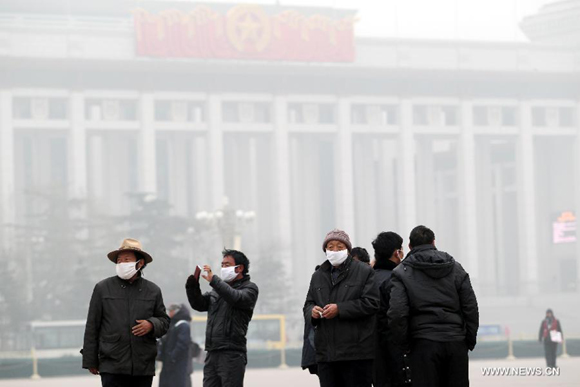Fog, haze lead to big spike in pollution levels
 0 Comment(s)
0 Comment(s) Print
Print E-mail China Daily, January 12, 2013
E-mail China Daily, January 12, 2013
Thick fog and haze shrouded central and northern parts of China on Friday, with Hebei and Henan provinces among the most polluted areas, monitoring data showed.
|
People visit the Tian'anmen Square in Beijing, capital of China, Jan. 11, 2013. The PM 2.5 (particles less than 2.5 microns) data in Beijing hit 240 to 446 on Friday, which means the 6 rating heavily polluted air quality. |
An air quality report from the Ministry of Environmental Protection ranked Handan, Baoding and Shijiazhuang in Hebei and Zhengzhou in Henan as the top four most-polluted cities among 120 monitored nationwide.
The Air Pollution Index in the four cities reached 500, the maximum on the index, on Friday. An API reading below 50 indicates excellent air quality, 50 to 100 indicates healthy air, and readings above 100 mean polluted air.
The bad weather is expected to continue, with cold fronts expected in mid-January, Ma Xuekuan, chief weather forecaster at the National Meteorological Center, told China Daily on Friday.
"Recent wet air, increasing pollutants and little wind mean haze formed easily. When cold snaps bring winds, haze and fog will be blown away," Ma said.
The haze brought traffic problems in Henan, with eight expressways in the province closed on Thursday because visibility was below 200 meters. No accidents or casualties due to the haze have been reported so far.
Experts and residents in the worst-hit areas such as Shijiazhuang are becoming increasingly worried about the air pollution brought by frequent winter haze.
"Small particles in the air can cause heart disease, stroke, respiratory illness, birth defects and cancer," said Zhou Rong, director of the Greenpeace climate and energy project.
Shijiazhuang has been enveloped by haze and fog since Sunday, according to the local weather bureau.
"I have rarely seen haze persist for so long. The air smells like burnt coal, and I have to cover my nose," said Li Ning, a worker in his 30s. "I really want to know if the haze has any impact on my health," he added.
Yang Ping, a doctor at Hebei Provincial People's Hospital, said there has been an increase in child and elderly patients since the haze started to affect Shijiazhuang on Sunday.
A report by Greenpeace and Peking University's School of Public Health said an estimated 8,572 premature deaths occurred in Shanghai, Guangzhou, Xi'an and Beijing in 2012 because of high levels of PM2.5 pollution. The report called for regional coal consumption to be capped.
PM2.5 refers to particles less than 2.5 micrometers in diameter, which can enter the lungs and bloodstream. Haze often means increased PM 2.5 density.
Chen Wanqing, deputy director of the National Central Cancer Registry, under the Ministry of Health, said that lung cancer is rising sharply in China and tends to affect young people, but did not explain why.
Beijing Environmental Protection Bureau warned residents to avoid staying outdoors for long after widespread haze reached the capital on Thursday night.
Zhang Lin, a weather forecaster at the Beijing Meteorological Bureau, told China Daily the city will see a bright weekend, with the haze ending on Friday afternoon.
China has taken various measures to fight air pollution. Since Jan 1, a total of 74 major cities have been required to issue daily reports on air quality by adopting more extensive monitoring standards, such as the PM 2.5 level.
In December, the authorities decided to spend 350 billion yuan (56 billion U.S. dollars) to lower the level of harmful particles in the air in 117 cities by at least 5 percent from 2011 to 2015.







Go to Forum >>0 Comment(s)